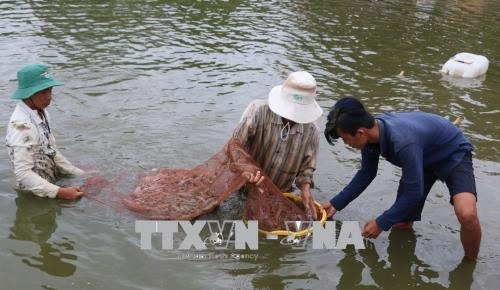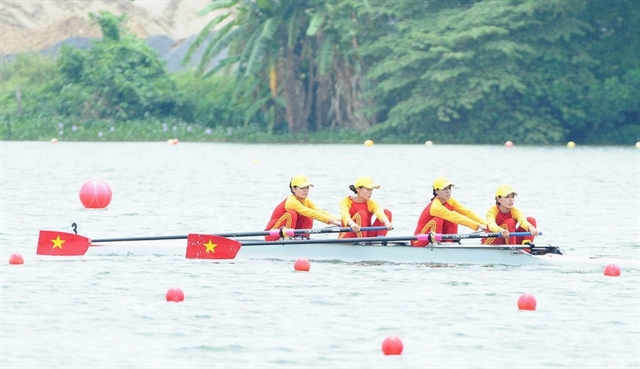 Society
Society

Minister of Agriculture and Rural Development Nguyễn Xuân Cường has ordered provinces and cities to focus on ensuring farmers raise shrimp using proper breeding processes and advanced techniques.
 |
| Farmers in the Cửu Long (Mekong) Delta province of Bạc Liêu harvest shrimp. - VNA/VNS Photo Huỳnh Sử |
HCM CITY – Minister of Agriculture and Rural Development Nguyễn Xuân Cường has ordered provinces and cities to focus on ensuring farmers raise shrimp using proper breeding processes and advanced techniques.
Speaking at a seminar held in Bạc Liêu Province on Sunday on measures to develop the shrimp sector sustainably, he urged provinces and cities to set up sustainable shrimp farming areas and ensure co-operation between farmers and processors and others in the production chain.
Farmers raise brackish shrimp on 637,000ha, slightly up from last year, including 582,000ha of black tiger shrimp and 54,500ha of white-legged shrimp, according to the Directorate of Fisheries.
In the first five months of this year a total of 200,000 tonnes of shrimp were harvested, an increase of 11.1 per cent year-on-year.
White-legged shrimp accounted for the increase in both area and output, the directorate said.
Như Văn Cẩn, head of the directorate’s department of aquaculture, said the shrimp sector faced several difficulties.
Their exports came up against technical barriers put up by importing countries and there were not enough market forecasts, he said.
The price of white-legged shrimp has fallen by VNĐ10,000 – 30,000 a kilogramme since April, according to the directorate.
Higher output in major shrimp producing countries and lower imports by major importers have been a double whammy, according to the Việt Nam Association of Seafood Exporters and Producers (VASEP).
Trương Đình Hòe, VASEP general secretary, said the price of raw shrimp, especially the white-legged variety, was not likely to increase by much this year.
Lê Văn Sử, deputy chairman of the Cà Mau Province People’s Committee, said the price of black tiger shrimp was steady and 40 per cent higher than that of white-legged shrimp.
The price of black tiger shrimp remains high since 2011.
The crustacean fetches VNĐ225,000 – 250,000 a kilogramme if it is of a size that makes 30 to a kilogramme.
Participants at the seminar agreed that farming of white-legged shrimp should be reduced in terms of both area and output this year, and that farmers needed to adopt techniques that helped reduce costs.
They should focus on black tiger shrimp and control shrimp diseases, they said.
Cường called on the directorate and other relevance agencies to efficiently forecast market conditions and warn farmers if their output seems likely to exceed demand.
The market would revive and so farmers should not panic and sell immature shrimp, he said.
“Shrimp processors should share in farmers’ difficulties and consider them long-term partners.”
He instructed agencies under his ministry to work with provinces and cities to help farmers adopt advanced techniques.
The ministry would work with other relevant ministries and sectors to resolve problems related to processing, infrastructure and prices to ensure the sustainable development of the shrimp sector, he promised.
Dead in the water
Meanwhile, in Long An Province, farmers are suffering huge losses.
Losing millions of đồng, shrimp farmers in Long An like Trương Thanh Nhàn suspended their farming to avoid debt, according to Nông Thôn Ngày Nay (Countryside Today) newspaper.
In Nhàn’s farm, ponds once filled with shrimps and aeration propellers are now deserted.
“Diseases wiped out most of my shrimp after solely a month farming. When I collected the leftovers, the prices were too low to make my investment back, let alone profit,” Nhàn said.
He lost VNĐ200 million (US$8,800) after two crop failures.
Lê Văn Hiệp, a trader in Long An, said prices ranged from VNĐ70,000 ($3.07) to VNĐ105,000 ($4.6). Nhàn claimed “if the financial values of shrimps stayed anchored at this rate — the lowest in three years’ time, I will cease cultivating shrimps.”
Shrimp farmers in Phước Lại Commune had suspended operation, Nguyễn Công Danh, vice chairman of the commune’s People’s Committee, reported.
Their counterparts in Tân Chánh Hamlet, the biggest feeding resource area for shrimps, were also said to be mulling suspending the farming of more than 100ha out of 850ha of shrimp ponds, according to Nguyễn Trọng Tuyên, Vice President of Tân Chánh Hamlet.
Phạm Phú Hùng, Deputy Executive of Agriculture Extension Centre in Long An, attributed the cause to the low financial value of crops compared with high-priced inputs, which resulted in massive losses for farmers.
“If the prices for crops went up, farmers would continue growing shrimps at the drop of a hat,” he noted.
Đồng Quang Đôn, Manager of Agriculture and Rural Development in Cần Giuộc District agreed, suggesting farmers continue their work at a steadily low pace to sustain the ponds and minimise market price risks. In the long-term, Đôn said cutting edge technology should be applied in shrimp farms.
A spread of infections for shrimps was another reason for crop failure, Phạm Phú Hùng added, so farmers should only count on credited shrimp breed sellers for input and renovate their ponds carefully.
Việt Nam’s shrimp exports to the US are in intense competition with India, according to cafef.vn, while traders were reported to only buy small prawns while refusing to take large shrimps.
Farmers all over Mekong Delta are facing the same issue, suspending their operation after their investment turned no profit, hoping for a rise in prices. —VNS




